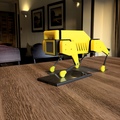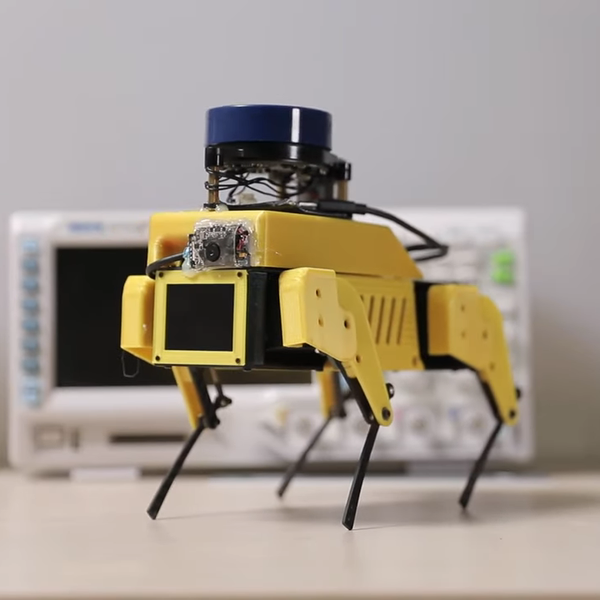 Hi all, Hack Chat starts in about 50 minutes:
Hi all, Hack Chat starts in about 50 minutes:

https://hackaday.io/event/181633-robot-dogs-hack-chat
Robot Dogs Hack Chat
Afreez Gan will host the Hack Chat on Wednesday, September 29 at noon Pacific. Time zones got you down? Try our handy time zone converter. Thanks to the efforts of a couple of large companies, many devoted hobbyists, and some dystopian science fiction, robot dogs have firmly entered the zeitgeist of our "living in the future" world.
 OK, thanks
OK, thanks
 I'm here already :)
I'm here already :)
 Hey Afreez, welcome aboard! We'll kick it off officially at noon PST, but everyone should feel free to chat.
Hey Afreez, welcome aboard! We'll kick it off officially at noon PST, but everyone should feel free to chat.
 Hey Dan, OK, many thanks for your great help!
Hey Dan, OK, many thanks for your great help!
 Wow! Congrats on the Kickstarter campaign.
Wow! Congrats on the Kickstarter campaign.
 Thanks! Hope Mini Pupper becomes better and better with many guys' help :)
Thanks! Hope Mini Pupper becomes better and better with many guys' help :)
 Kat just said I'm a good man :)
Kat just said I'm a good man :)


 Kat is from ROS community.
Kat is from ROS community.
 After a cup of coffee, I'm refreshed.
After a cup of coffee, I'm refreshed.
 OK, folks, let's get started. Welcome to the Hack Chat, I'm Dan and I'll be moderating today along with Dusan for Afreeze Gan. We're talking about Robot Dogs today!
OK, folks, let's get started. Welcome to the Hack Chat, I'm Dan and I'll be moderating today along with Dusan for Afreeze Gan. We're talking about Robot Dogs today!
 Hello and welcome!
Hello and welcome!
 Hey every one, nice to meet you here.
Hey every one, nice to meet you here.
I'm Afreez from MangDang company, Mini Pupper Product manager.
Mini Pupper is an Open-Source,ROS Robot Dog Kit
Mini Pupper will make robotics easier for schools, homeschool families, enthusiasts and beyond.
It's my pleasure to share anything you want to know about Mini Pupper.

 Hello!
Hello!
 Hello Anna :)
Hello Anna :)
 Can you maybe start us off with a little on your background?
Can you maybe start us off with a little on your background?
 Yeah, I worked about 20 years, as a engineer, team leader, project manager, product manager
Yeah, I worked about 20 years, as a engineer, team leader, project manager, product manager
 "Mini Pupper" is a great name. Very cool project too!
"Mini Pupper" is a great name. Very cool project too!
 From last year, I set up MangDang to focus on robot dog,Mini Pupper.
From last year, I set up MangDang to focus on robot dog,Mini Pupper.
 I studied robot dog from Stanford Pupper project, an awesome open source project.
I studied robot dog from Stanford Pupper project, an awesome open source project.
 Are you based in China? If so, how has that made developing MiniPupper easier or harder?
Are you based in China? If so, how has that made developing MiniPupper easier or harder?
 Yes, our company is located in Hong Kong, now I'm located in Beijing, but our team is a really global team.
Yes, our company is located in Hong Kong, now I'm located in Beijing, but our team is a really global team.
 It looks easy, but not really easy.
It looks easy, but not really easy.
 we built Mini Pupper prototype last Oct. but spent long time to make it stable.
we built Mini Pupper prototype last Oct. but spent long time to make it stable.
 Anyone try a build with springs in the legs?
Anyone try a build with springs in the legs?
 For extra distance? Hehe
For extra distance? Hehe
 It's a good idea with springs in the legs
It's a good idea with springs in the legs
 It depends on the mechanical design. You can see some robot dogs are with springs in the legs.
It depends on the mechanical design. You can see some robot dogs are with springs in the legs.
 I watched some of the videos, and the robot looks great. One thing I noticed was the "steppy" servo movements. Is that a function of the resolution available in the motor position feedback (potentiometer I assume)?
I watched some of the videos, and the robot looks great. One thing I noticed was the "steppy" servo movements. Is that a function of the resolution available in the motor position feedback (potentiometer I assume)?
 I'm curious about what kind of motors are being used to drive the legs. I think the bigger dogs have BLDCs with harmonic drives or planetary gearboxes. And I've seen smaller dogs use nothing but hobby servos. But is there something in between those extremes?
I'm curious about what kind of motors are being used to drive the legs. I think the bigger dogs have BLDCs with harmonic drives or planetary gearboxes. And I've seen smaller dogs use nothing but hobby servos. But is there something in between those extremes?
 That is one of the key problems.
That is one of the key problems.
 there are dynamixel "smart" servos out there, but until recently they were pretty expensive
there are dynamixel "smart" servos out there, but until recently they were pretty expensive
 they do provide position feedback and different profiles, though
they do provide position feedback and different profiles, though
 It's not too difficult to do position feedback on the bigger dogs that have BLDCs with harmonic drives or planetary gearboxes. but it is hard for hobby servos.
It's not too difficult to do position feedback on the bigger dogs that have BLDCs with harmonic drives or planetary gearboxes. but it is hard for hobby servos.
 Are the sensors and controls generic enough to run any kind of robot? Or was this hand built specific to dog like skills and behaviors?
Are the sensors and controls generic enough to run any kind of robot? Or was this hand built specific to dog like skills and behaviors?
 @Afreez Gan can't you just add another wire to the internal pot of the servo, and use the ADC?
@Afreez Gan can't you just add another wire to the internal pot of the servo, and use the ADC?
 Actually, we are also trying with dynamixel servo, but still not have a conclusion.
Actually, we are also trying with dynamixel servo, but still not have a conclusion.
 hey Andy! there's no feedback from the servos. the steppy look was because we used ROS host-master, that's to say, send the joint angles from the computer, and the rsaperry pi on the robot dog will receive the angles. the steppy look was because of the network
hey Andy! there's no feedback from the servos. the steppy look was because we used ROS host-master, that's to say, send the joint angles from the computer, and the rsaperry pi on the robot dog will receive the angles. the steppy look was because of the network
 I see. The loop is closed out at the servo, as each servo is updated in a sequence, round-robin style.
I see. The loop is closed out at the servo, as each servo is updated in a sequence, round-robin style.
 Onhc is one of our team member.
Onhc is one of our team member.
 yes, and I think this is what we should focus on in the future. if feedback is added, we can apply some reinforcement learning algorithms
yes, and I think this is what we should focus on in the future. if feedback is added, we can apply some reinforcement learning algorithms
 The winner from the Hackaday prize (2018 or 19) with the high precision robotic arm using magnets in a low cost/clever way to provide joint feedback comes to mind as a possible solution path.
The winner from the Hackaday prize (2018 or 19) with the high precision robotic arm using magnets in a low cost/clever way to provide joint feedback comes to mind as a possible solution path.
 Our target is to build a powerful, better, cheaper robot dog platform to make robotics easier for schools, homeschool families, enthusiasts and beyond.
Our target is to build a powerful, better, cheaper robot dog platform to make robotics easier for schools, homeschool families, enthusiasts and beyond.
 Mini Pupper is only our beginning journey.
Mini Pupper is only our beginning journey.
 Hmm... are you hinting at bigger robots?
Hmm... are you hinting at bigger robots?
 I'm also a fan or Carl Bujega's pcb motor exploration for smaller moving parts, though torque is limited
I'm also a fan or Carl Bujega's pcb motor exploration for smaller moving parts, though torque is limited
 I was just typing that same question...
I was just typing that same question...
 We will focus on similar Mini Pupper robot.
We will focus on similar Mini Pupper robot.
 +1 on Carl. I really should ask him to do a Hack Chat
+1 on Carl. I really should ask him to do a Hack Chat
 @onhc You might want to simulate the various designs, then you won't be limited with assemblies. That also fits with designing better cheaper "anything". It teaches robotics, sensing, modeling, cost estimation, project management, group collaboration.
@onhc You might want to simulate the various designs, then you won't be limited with assemblies. That also fits with designing better cheaper "anything". It teaches robotics, sensing, modeling, cost estimation, project management, group collaboration.
 Yeah, I think because servos are usually applied in model airplane or rc cars, it's actually not invented for robots. Maybe we could find a way to make a low-cost actuator. And I think simulation is a good idea but there's still a lot for us to learn...
Yeah, I think because servos are usually applied in model airplane or rc cars, it's actually not invented for robots. Maybe we could find a way to make a low-cost actuator. And I think simulation is a good idea but there's still a lot for us to learn...
 Serious question: have you had any problems with Boston Dynamics because of MiniPupper's color scheme? I know some companies have trademark protections on colors, just wondering if anyone has complained.
Serious question: have you had any problems with Boston Dynamics because of MiniPupper's color scheme? I know some companies have trademark protections on colors, just wondering if anyone has complained.
 How are you looking at developing behavioral programming in the future in regards to education, family, and assistive ideologies?
How are you looking at developing behavioral programming in the future in regards to education, family, and assistive ideologies?
 hey @Metalnat! We are also developing high-performance servos with magnetic encoders and torque feedback now,still need a lot of work.
hey @Metalnat! We are also developing high-performance servos with magnetic encoders and torque feedback now,still need a lot of work.
 @Metalnat @RichardCollins we are welcome to join us to optimize or re-design a better version :)
@Metalnat @RichardCollins we are welcome to join us to optimize or re-design a better version :)
 haha BD would be the ones to have an issue if any. We were told "no" real quick when we requested one for purchase when we mentioned putting a robot claw on it to rip posters off a wall.. then we went Ghost Robotics and did our thing.
haha BD would be the ones to have an issue if any. We were told "no" real quick when we requested one for purchase when we mentioned putting a robot claw on it to rip posters off a wall.. then we went Ghost Robotics and did our thing.
 About the serious question, Mini Pupper is only Open source project, its target is education, but not a consumer product.
About the serious question, Mini Pupper is only Open source project, its target is education, but not a consumer product.
 @Onhc I designed robots with neural nets in high school. Which for me was more than 50 years ago. I took my first graduate course in artificial intelligence in 1968. All that has changed is the cost and size of components. And "AI" has been co-opted by marketers. Now I say "intelligent algorithms".
@Onhc I designed robots with neural nets in high school. Which for me was more than 50 years ago. I took my first graduate course in artificial intelligence in 1968. All that has changed is the cost and size of components. And "AI" has been co-opted by marketers. Now I say "intelligent algorithms".
 @Anna Camburn That is our next step, you know, Mini Pupper is still very young, we are developing some AI features to make it smarter.
@Anna Camburn That is our next step, you know, Mini Pupper is still very young, we are developing some AI features to make it smarter.
 The Kickstarter "complete kit" contains both a "controller" and a Raspberry Pi. What is the controller, and what does it do?
The Kickstarter "complete kit" contains both a "controller" and a Raspberry Pi. What is the controller, and what does it do?
 controller means just like PS4 controller, to control Mini Pupper
controller means just like PS4 controller, to control Mini Pupper
 You can control Mini Pupper by the controller, or just use a simulator software run on PC
You can control Mini Pupper by the controller, or just use a simulator software run on PC
 Ah, got it.
Ah, got it.
 Actually, we are trying to throw away the controller with AI functions
Actually, we are trying to throw away the controller with AI functions
 but we still need time to move forward step by step.
but we still need time to move forward step by step.
 Our dream is to communicate with Mini Pupper by voice, gesture, but not controller.
Our dream is to communicate with Mini Pupper by voice, gesture, but not controller.
 @Afreez Gan If I were doing it, I would move the processor and memory "off dog" and simply run it remotely, share the algorithm development globally, and test by simulation. Then, any algorithms could be applied to any shape or size. "Good" algorithms should be shape and size independent to a great extent.
@Afreez Gan If I were doing it, I would move the processor and memory "off dog" and simply run it remotely, share the algorithm development globally, and test by simulation. Then, any algorithms could be applied to any shape or size. "Good" algorithms should be shape and size independent to a great extent.
 i don't know if this info is helpful but in the case of the ghost robotics dogs we had a cellphone sent as controller and all comms were handled by wifi that was hosted on the robot dog itself. worked great at the shop but wifi in a densely active street near a bunch of stores did not work as well.
i don't know if this info is helpful but in the case of the ghost robotics dogs we had a cellphone sent as controller and all comms were handled by wifi that was hosted on the robot dog itself. worked great at the shop but wifi in a densely active street near a bunch of stores did not work as well.
 Yeah, I have to say, technically it is right. but it is hard to make a product.
Yeah, I have to say, technically it is right. but it is hard to make a product.
 we did put in motion to convert it to a standard RF remote build but need to update firmware to fix key bindings. a specific direction on the joystick happens to also be the E-stop feature..
we did put in motion to convert it to a standard RF remote build but need to update firmware to fix key bindings. a specific direction on the joystick happens to also be the E-stop feature..
 There is still a lot of room for improvement from idealized artificial intelligence.
There is still a lot of room for improvement from idealized artificial intelligence.
 @RichardCollins Actually I'm just a ROS developer for Mini Pupper project and now I'm just a junior student. And actually the ROS package we are using is suitable for any kind of quadruped robots. the only thing required is the urdf file of the robot(actually the prometers of the length of legs and so on...). So, yes, the algorithm can be independent from shape and size
@RichardCollins Actually I'm just a ROS developer for Mini Pupper project and now I'm just a junior student. And actually the ROS package we are using is suitable for any kind of quadruped robots. the only thing required is the urdf file of the robot(actually the prometers of the length of legs and so on...). So, yes, the algorithm can be independent from shape and size
 @Afreez Gan If you wqrk from the premise that it will be a global community collaborating to advance algorithms of this sort for all countries, peoples, technologies and sciences, then that cost is born by everyone. Your effort is one example that interested people can join. But the benefits of new best methods are shared globally, not to enrich a few. It is easy to make industries of a few billion dollars (I work on the whole Internet and all uses of knowledge for the Internet Foundation), What cripples development is where a few twitch critical pieces to benefit themselves.
@Afreez Gan If you wqrk from the premise that it will be a global community collaborating to advance algorithms of this sort for all countries, peoples, technologies and sciences, then that cost is born by everyone. Your effort is one example that interested people can join. But the benefits of new best methods are shared globally, not to enrich a few. It is easy to make industries of a few billion dollars (I work on the whole Internet and all uses of knowledge for the Internet Foundation), What cripples development is where a few twitch critical pieces to benefit themselves.
 @Metalnat WiFi connection is always a problem when the environment is not clear, haha
@Metalnat WiFi connection is always a problem when the environment is not clear, haha
 Nice @0nhc and @RichardCollins
Nice @0nhc and @RichardCollins
 Wifi can be encrypted and error corrected. Lots of algorithms.
Wifi can be encrypted and error corrected. Lots of algorithms.
 In my previous projects, we often spend several month to find the root cause of WiFi connection and performance.
In my previous projects, we often spend several month to find the root cause of WiFi connection and performance.
 @RichardCollins Exactly, that is why we have a good relationship with Hackaday, ROS, OpenCV communities.
@RichardCollins Exactly, that is why we have a good relationship with Hackaday, ROS, OpenCV communities.
 @Metalnat I also have a quadrued robot based on MIT Mini Cheetah. It's also controlled with smartphone in the same wifi. As I tested it worked well in all circumstances. But actually Mini Pupper is used for education, and it's not suitable for such environments you mentioned. So... the connection problems may be not considered for Mini Pupper.
@Metalnat I also have a quadrued robot based on MIT Mini Cheetah. It's also controlled with smartphone in the same wifi. As I tested it worked well in all circumstances. But actually Mini Pupper is used for education, and it's not suitable for such environments you mentioned. So... the connection problems may be not considered for Mini Pupper.
 we want to build a good product, connect global talents, produce lots of people benefit, and also get benefit to increase developing better products.
we want to build a good product, connect global talents, produce lots of people benefit, and also get benefit to increase developing better products.
 wifi interference is being worked on by tens of thousands of groups globally. But they are not working together. I took over the Internet Foundation from Network Solutions when the original Foundation was cancelled for political reasons. In 23 years I have seen groups of all sizes on every possible topic, not working together. "I want to do it myself", "We only want to have our group share what we learn" impoverishes the world.
wifi interference is being worked on by tens of thousands of groups globally. But they are not working together. I took over the Internet Foundation from Network Solutions when the original Foundation was cancelled for political reasons. In 23 years I have seen groups of all sizes on every possible topic, not working together. "I want to do it myself", "We only want to have our group share what we learn" impoverishes the world.
 How are you dealing with reduced space for batteries on a smaller robot? Big dogs can really pack in the power -- any tricks to getting enough battery to a small dog so it can last a good while?
How are you dealing with reduced space for batteries on a smaller robot? Big dogs can really pack in the power -- any tricks to getting enough battery to a small dog so it can last a good while?
 Transmit the power. That is growing fast.
Transmit the power. That is growing fast.
 I have to get going to something else. Thank you so much for what you are doing. I will try to find time to look closer at your group. Money is easy, balance and purpose are hard.
I have to get going to something else. Thank you so much for what you are doing. I will try to find time to look closer at your group. Money is easy, balance and purpose are hard.
 Thanks so much, keep in touch.
Thanks so much, keep in touch.
 ok
ok
 @Dan Maloney About battery, now it's about 30 minutes to charge Mini Pupper battery, and can use about 25 minutes.
@Dan Maloney About battery, now it's about 30 minutes to charge Mini Pupper battery, and can use about 25 minutes.
 Any plans for a sim2real curriculum for K-12 educators with limited funding to purchase the Mini Pupper?
Any plans for a sim2real curriculum for K-12 educators with limited funding to purchase the Mini Pupper?
 It's OK for education, we have not found better battery for Mini Puper yet.
It's OK for education, we have not found better battery for Mini Puper yet.
 That's reasonable. Any plans for a "doggie bed" docking station that it can lie on to recharge?
That's reasonable. Any plans for a "doggie bed" docking station that it can lie on to recharge?
 Actually, we discussed the auto-charge function many times. we need more time.
Actually, we discussed the auto-charge function many times. we need more time.
 Also there is still some space for large capacity batteries, and if needed, we can custom batteries with certain size.
Also there is still some space for large capacity batteries, and if needed, we can custom batteries with certain size.
 @Myrna Bonin We're developing Gazebo supporting
@Myrna Bonin We're developing Gazebo supporting
 Custom means big volume, my brother, haha
Custom means big volume, my brother, haha
 Thank you.
Thank you.
 Still, half-hour runtime isn't bad, especially for a classroom situation.
Still, half-hour runtime isn't bad, especially for a classroom situation.
 *Remembers attention span of his own kids* Yep, 30 minutes is plenty ;-)
*Remembers attention span of his own kids* Yep, 30 minutes is plenty ;-)
 @Myrna Bonin we are also developing our next version robot, our target is less than $300USD
@Myrna Bonin we are also developing our next version robot, our target is less than $300USD
 When we get enough backer from the campaign, we have powerful sourcing capability, that means, big volume, low price.
When we get enough backer from the campaign, we have powerful sourcing capability, that means, big volume, low price.
 That will make the product much more accessible.
That will make the product much more accessible.
 Now Mini Pupper price is almost half of Stanford Pupper, I hope our next version is half of Mini Pupper.
Now Mini Pupper price is almost half of Stanford Pupper, I hope our next version is half of Mini Pupper.
 Dan Maloney
Dan Maloney
Discussions
Become a Hackaday.io Member
Create an account to leave a comment. Already have an account? Log In.